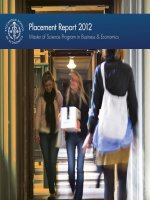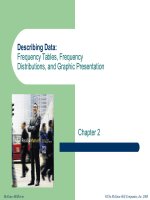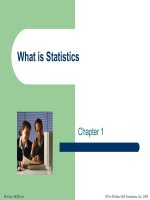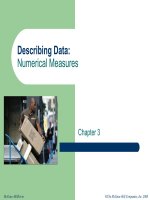Stastical technologies in business economics chapter 18
Bạn đang xem bản rút gọn của tài liệu. Xem và tải ngay bản đầy đủ của tài liệu tại đây (1.02 MB, 43 trang )
Non-parametric:
Analysis of Ranked Data
Chapter 18
McGraw-Hill/Irwin
©The McGraw-Hill Companies, Inc. 2008
GOALS
2
Conduct the sign test for dependent samples using the
binomial and standard normal distributions as the test statistics.
Conduct a test of hypothesis for dependent samples using the
Wilcoxon signed-rank test.
Conduct and interpret the Wilcoxon rank-sum test for
independent samples.
Conduct and interpret the Kruskal-Wallis test for several
independent samples.
Compute and interpret Spearman’s coefficient of rank
correlation.
Conduct a test of hypothesis to determine whether the
correlation among the ranks in the population is different from
zero.
The Sign Test
The Sign Test is based on the sign of a difference
between two related observations.
3
No assumption is necessary regarding the shape of the
population of differences.
The binomial distribution is the test statistic for small
samples and the standard normal (z) for large samples.
The test requires dependent (related) samples.
The Sign Test
continued
Procedure to conduct the test:
4
Determine the sign (+ or -) of the difference between
related pairs. Determine the number of usable pairs.
Compare the number of positive (or negative)
differences to the critical value.
n is the number of usable pairs (without ties), X is the
number of pluses or minuses, and the binomial
probability π = .5
The Sign Test - Example
The director of information systems at
Samuelson Chemicals recommended
that an in-plant training program be
instituted for managers. The objective is
to improve the knowledge of database
usage in accounting, procurement,
production, and so on. A sample of 15
managers was selected at random. A
panel of database experts determined
the general level of competence of each
manager with respect to using the
database. Their competence and
understanding were rated as being
either outstanding, excellent, good, fair,
or poor. After the three-month training
program, the same panel of information
systems experts rated each manager
again. The two ratings (before and
after) are shown along with the sign of
the difference. A “+” sign indicates
improvement, and a “-” sign indicates
that the manager’s competence using
databases had declined after the
training program.
Did the in-plant training program effectively
increase the competence of the
managers using the company’s
database?
5
Step 1: State the Null and Alternative Hypotheses
H0: π ≤.5 (There is no increase in competence as a result of the inplant training program.)
H1: π >.5 (There is an increase in competence as a result of the inplant training program.)
Step 2: Select a level of significance.
We chose the .10 level.
Step 3: Decide on the test statistic.
It is the number of plus signs resulting from the
experiment.
Step 4: Formulate a decision rule.
.
6
7
8
9
In this example α is .10.
The probability of 3 or fewer successes is .029,
found by .000 + .001 + .006 + .022.
The probability of 11 or more successes is also .029.
Adding the two probabilities gives .058. This is the
closest we can come to .10 without exceeding it.
Hence, the decision rule for a two-tailed test would
be to reject the null hypothesis if there are 3 or fewer
plus signs, or 11 or more plus signs.
Step 5: Make a decision regarding the null
hypothesis.
Eleven out of the 14 managers in the training course
increased their database competency. The number 11 is
in the rejection region, which starts at 10, so is rejected.
We conclude that the three-month training course was
effective. It increased the database competency of the
managers.
1
Normal Approximation
1
If the number of observations in the sample is
larger than 10, the normal distribution can be
used to approximate the binomial.
Normal Approximation - Example
The market research department of Cola, Inc., has been given the
assignment of testing a new soft drink. Two versions of the
drink are considered—a rather sweet drink and a somewhat
bitter one. A preference test is to be conducted consisting of a
sample of 64 consumers. Each consumer will taste both the
sweet cola (labeled A) and the bitter one (labeled B) and
indicate a preference. Conduct a test of hypothesis to
determine if there is a difference in the preference for the sweet
and bitter tastes. Use the .05 significance level.
1
Normal Approximation - Example
1
Normal Approximation - Example
1
Wilcoxon Signed-Rank Test for
Dependent Samples
If the assumption of normality is violated for
the paired-t test, use the Wilcoxon Signedrank test.
1
The test requires the ordinal scale of measurement.
The observations must be related or dependent.
Wilcoxon Signed-Rank Test
The steps for the test are:
1
Compute the differences between related
observations.
Rank the absolute differences from low to high.
Return the signs to the ranks and sum positive and
negative ranks.
Compare the smaller of the two rank sums with the T
value, obtained from Appendix B.7.
Wilcoxon Signed-Rank Test for
Dependent Samples - Example
1
Fricker’s is a family restaurant chain
located primarily in the southeastern
part of the United States. It offers a full
dinner menu, but its specialty is
chicken. Recently, Fricker, the owner
and founder, developed a new spicy
flavor for the batter in which the
chicken is cooked. Before replacing
the current flavor, he wants to conduct
some tests to be sure that patrons will
like the spicy flavor better. To begin,
Bernie selects a random sample of 15
customers. Each sampled customer is
given a small piece of the current
chicken and asked to rate its overall
taste on a scale of 1 to 20. A value
near 20 indicates the participant liked
the flavor, whereas a score near 0
indicates they did not like the flavor.
Next, the same 15 participants are
given a sample of the new chicken with
the spicier flavor and again asked to
rate its taste on a scale of 1 to 20.
The results are reported in the table on the
right. Is it reasonable to conclude that
the spicy flavor is preferred? Use the .
05 significance level.
Wilcoxon Signed-Rank Test for
Dependent Samples - Example
1
1
Each assigned rank in column 6 is then given the
same sign as the original difference, and the results
are reported in column 7. For example, the second
participant has a difference score of 8 and a rank of
6. This value is located in the section of column 7.
The R+ and R- columns are totaled. The sum of the
positive ranks is 75 and the sum of the negative
ranks is 30.
The smaller of the two rank sums is used as the test
statistic and referred to as T.
2
The critical values for the Wilcoxon signed-rank test
are located in Appendix B.7. A portion of that table is
shown on the table below.
2
The value at the intersection is 25, so the critical
value is 25.
The decision rule is to reject the null hypothesis if the
smaller of the rank sums is 25 or less. The value
obtained from Appendix B.7 is the largest value in
the rejection region. To put it another way, our
decision rule is to reject if the smaller of the two rank
sums is 25 or less.
In this case the smaller rank sum is 30, so the
decision is not to reject the null hypothesis. We
cannot conclude there is a difference in the flavor
ratings between the current and the spicy.
Wilcoxon Rank-Sum Test
The Wilcoxon Rank-Sum Test is
used to determine if two
independent samples came from
the same or equal populations.
2
No assumption about the shape of the population is
required.
The data must be at least ordinal scale.
Each sample must contain at least eight
observations.
Wilcoxon Rank-Sum Test
To
determine the value of the test
statistic W, all data values are
ranked from low to high as if they
were from a single population.
The
sum of ranks for each of the
two samples is determined.
2
Wilcoxon Rank-Sum Test for Independent
Samples
2
The Wilcoxon rank-sum test is based on the sum of ranks. The
data are ranked as if the observations were part of a single
sample.
The sum of ranks for each of the two samples is determined
If the null hypothesis is true, then the ranks will be about evenly
distributed between the two samples, and the sum of the ranks
for the two samples will be about the same.
Wilcoxon Rank-Sum Test for Independent
Samples - Example
Dan Thompson, the president of
CEO Airlines, recently noted an
increase in the number of noshows for flights out of Atlanta. He
is particularly interested in
determining whether there are
more no-shows for flights that
originate from Atlanta compared
with flights leaving Chicago. A
sample of nine flights from Atlanta
and eight from Chicago are
reported in Table 18–4. At the .05
significance level, can we
conclude that there are more noshows for the flights originating in
Atlanta?
2









